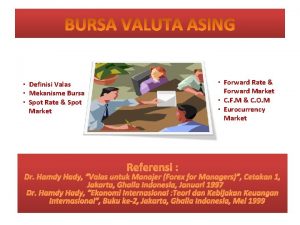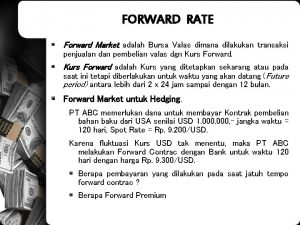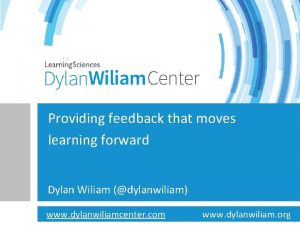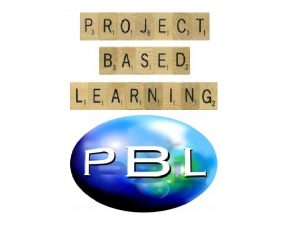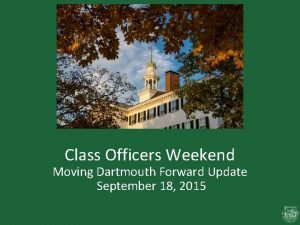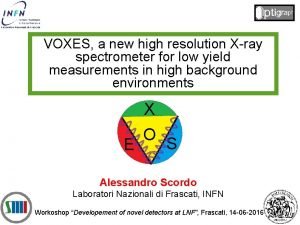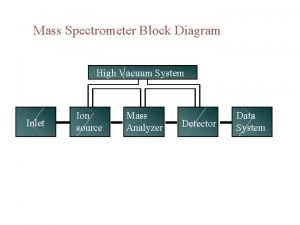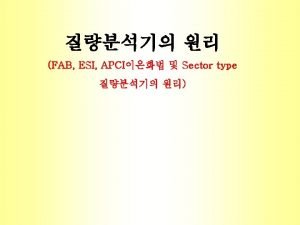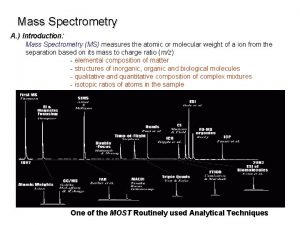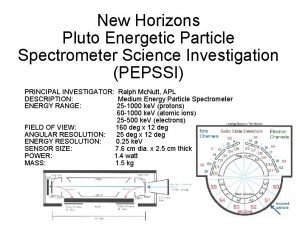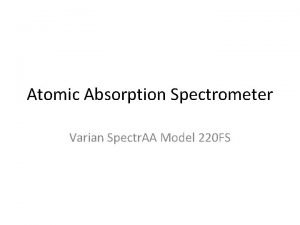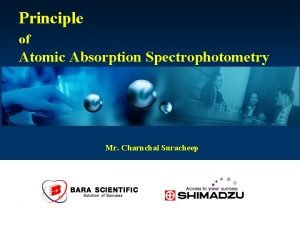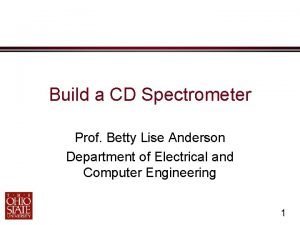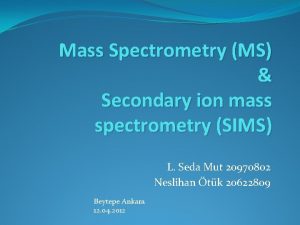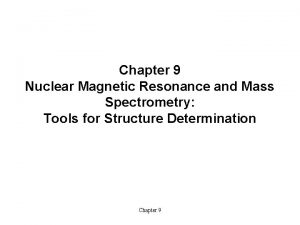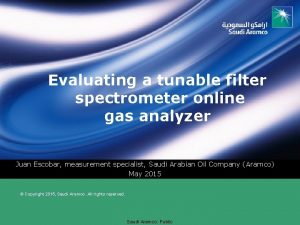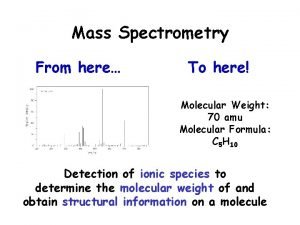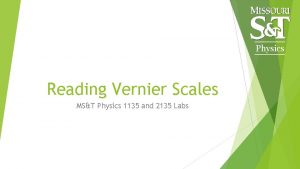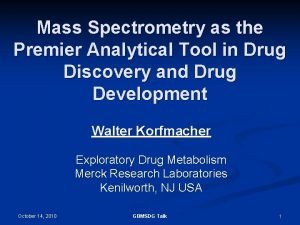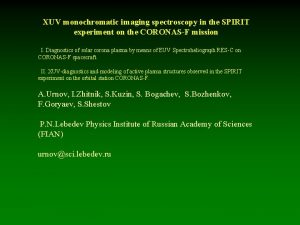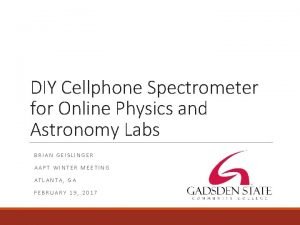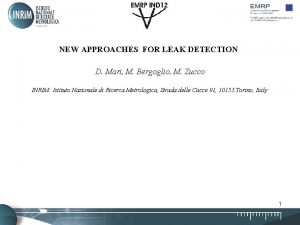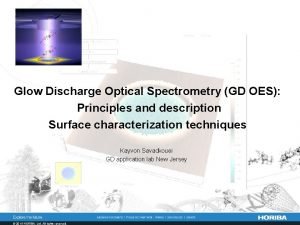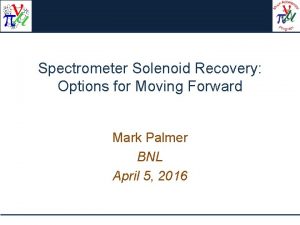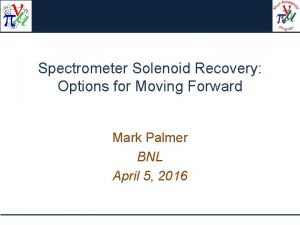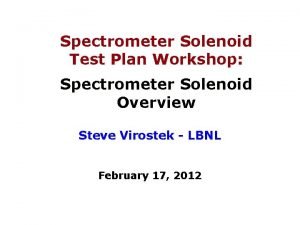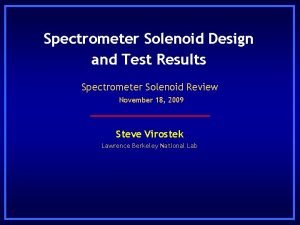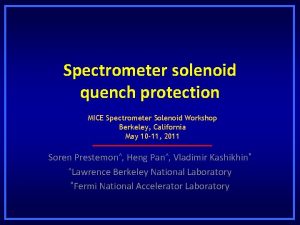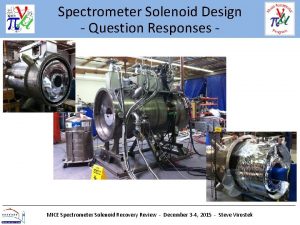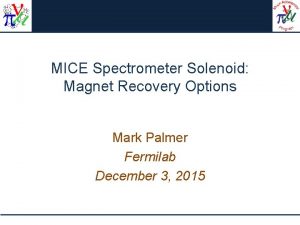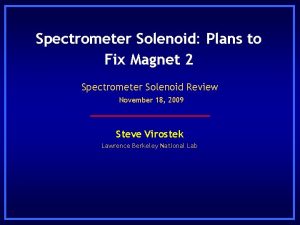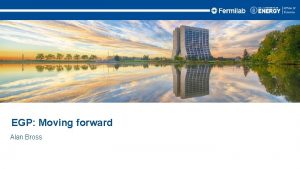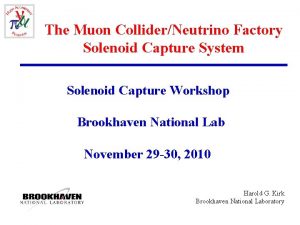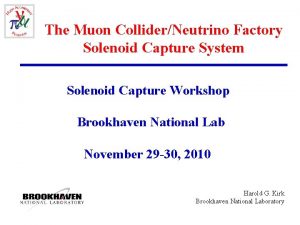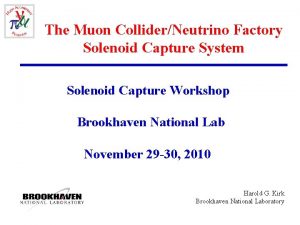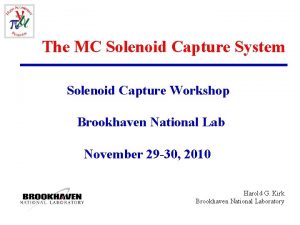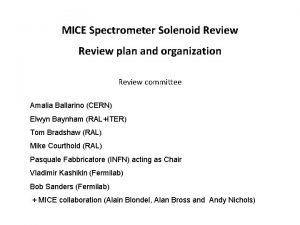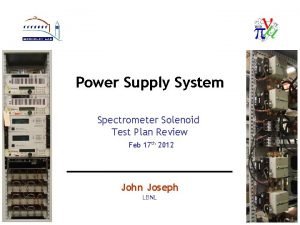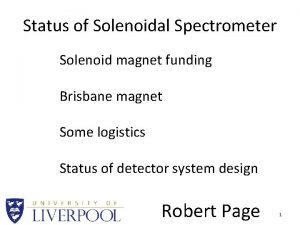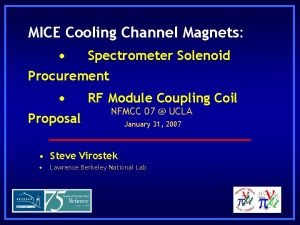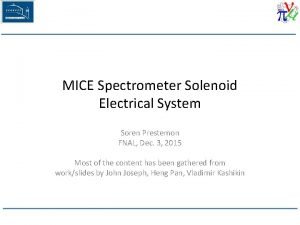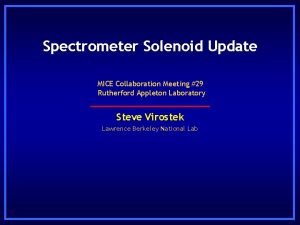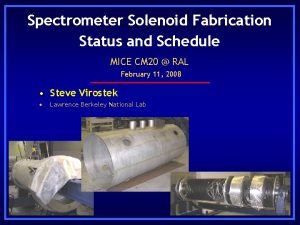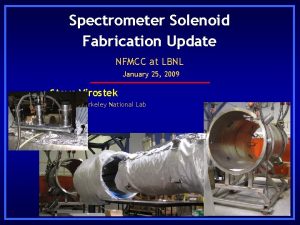Spectrometer Solenoid Recovery Options for Moving Forward Mark

























- Slides: 25

Spectrometer Solenoid Recovery: Options for Moving Forward Mark Palmer Fermilab October 26, 2015

Introduction • As noted, SSD-M 1 failed during magnet training quench on September 13, 2015 • Critical Questions for Moving Forward: 1. Can we operate MICE Step IV with the SSD as is? • The August 2014 re-baseline constrained the optics to the extent that we do not believe that the Cooling Demonstration configuration can operate without restoring the lost match coil functionality 2. Do we have a viable path to repair the magnet? 3. How long is a repair or alternative mitigation? And can it fit within the time frame (by end US FY 17) for deploying the cooling demonstration? 4. What is the required cost of a repair or alternative mitigation? Does it fit within the contingency held within the US construction budget? 5. Given the known “features” of the SS magnets (e. g. training behavior), are there steps in a repair that can significantly mitigate risk, overall experimental schedule, training schedule, and/or training costs? October 26, 2015 Mark Palmer | Spectrometer Solenoid Review (RAL, October 26, 2015) 2

Outline • Addressing the Key Questions 1. 2. 3. 4. 5. Step IV? Repair Path? Schedule? Cost? Risks? • Potential Technical Paths Forward • Process Moving Forward • Conclusion a Discussion October 26, 2015 Mark Palmer | Spectrometer Solenoid Review (RAL, October 26, 2015) 3

1. Step IV? Can we operate MICE Step IV with the SSD as is? • Optics designs sufficient for characterizing absorber materials are in hand (assuming SSD M 2 coil is operational): – Critical SSD checks: • SSD E-C-E quench and reasonable response of vessel a He vessel and feedthrough integrity satisfactory • SSD M 2 low current checkout a – a No anomalous resistive behavior observed Next step is a careful ramp to high current Viable optics and likely viable magnet with M 2 and E-C-E coils • Plan is to proceed with modified Step IV run plan for ~1 year a Time to prepare for a repair Answer: YES – Caveats: • Still need to validate magnet at currents required by alternative optics • Need to confirm that we have a power supply configuration that is “safe” for operations October 26, 2015 Mark Palmer | Spectrometer Solenoid Review (RAL, October 26, 2015) 4

PSU Configuration (Preliminary) Heng Pan (LBNL) • Quad model built in VF • Quench initiated in the inner layer of the E 2 coil. • All coils are powered by a single powers supply. • A 20 Ω external resistor goes across all the coils. • Switch opened when the overall voltage across the E 2 coil exceeds 0. 2 V. October 26, 2015 Mark Palmer | Spectrometer Solenoid Review (RAL, October 26, 2015) 5

Current Decay & Hot Spots Current Decay Hot Spot Temperature 140 300 250 I (A) 200 150 100 80 Tma x_C 1 60 100 40 50 20 0 -1 C coil also has the highest hot spot temperature among the coils. 120 T (K) C 1_I C 2_I E 1_I E 2_I M 1_I M 2_I Tma x_C 2 0 4 9 14 0 2 Time (s) 4 6 8 14 Hot Spot Temperature 100 Temperature (K) Heng Pan (LBNL) 12 Time (s) 120 Compare with nominal configuration (as shown in S. Prestemon’s talk) 10 80 Tmax_C 1 Tmax_C 2 Tmax_E 1 Tmax_E 2 Tmax_M 1 Tmax_M 2 60 40 20 0 0 5 10 15 Time (s) October 26, 2015 Mark Palmer | Spectrometer Solenoid Review (RAL, October 26, 2015) 6

2. Repair Path? Do we have a viable path to repair the magnet? • Both magnets previously rebuilt – One previous failure very similar in scope to present case – A plausible repair path exists based on previous repair and our present understanding of the September 13 th failure Answer: YES • Remaining question is whether a repeat of that rebuild is a “sufficient” and/or best option – Proposals to build an “improved” bobbin • Build and test prior to removal of magnet from channel (risk reduction) • Vacuum impregnated coils (vs. wet layup) • Active quench protection (heaters) – Insert separate function magnet in lieu of repair October 26, 2015 Mark Palmer | Spectrometer Solenoid Review (RAL, October 26, 2015) 7

Schedule? • Baseline estimate of repair schedule: – Based on prior experience with previous repairs – Assume magnet available (i. e. warm and ready to remove from channel) on August 1, 2016 • Base estimate for disassembly, cold mass repair and reassembly: 8 months base + 3 months contingency • Transport: 1. 5 months (if repair not carried out locally) • Installation, pump-down, cool-down and training at RAL (assuming optimal installation/commissioning support): 2 months a October 15, 2017 Answer: October 26, 2015 MAYBE Mark Palmer | Spectrometer Solenoid Review (RAL, October 26, 2015) 8

Cost? • Baseline Repair (very preliminary) – Air Shipment (required to achieve schedule): $100 K rnd-trip – Cold mass removal, repair, re-installation: $700 K base cost +35% contingency = $950 K – LHe costs (cool-down+training): 18 x 500 L x 7000 GBP/dewar x 1. 55$/GBP = $200 K – Misc. other costs = $100 K – Total: ~$1. 35 M • US Funding Availability – In $18 M FY 15 -17 ramp-down plan, US project has ~$1. 3 M in unallocated management reserve – Potentially would be forced to reduce US experimental support in FY 17 (particularly since no experimental running would take place) Answer: October 26, 2015 Probably Mark Palmer | Spectrometer Solenoid Review (RAL, October 26, 2015) 9

Risk? • Do we have a safe way to operate the two spectrometer solenoids as presently configured (assuming no further QA issues)? Maybe • Can risks be mitigated by the repair strategy? – Re-do SSD cold-mass QA (except for winding) – Improve stabilization of existing leads/bus work – Add additional protection features Yes • By addressing the above issues, do we convince ourselves that the magnet will be robust in operation? Maybe Overall Answer: Maybe October 26, 2015 Mark Palmer | Spectrometer Solenoid Review (RAL, October 26, 2015) 10

POTENTIAL TECHNICAL PATHS FORWARD October 26, 2015 Mark Palmer | Spectrometer Solenoid Review (RAL, October 26, 2015) 11

Potential Technical Paths Forward • Option 1 – Repeat previous repair scenario – Assumptions • NO changes to magnet design • Repair starts at conclusion of Step IV running • Suitable repair team available – magnet moved to team location – Schedule • Magnet could be at RAL for installation/commissioning prior to end of US FY 17. Would fully become RAL responsibility at end of US FY 17. – Cost • Nominally appears to use 100% of MAP management reserve funds. Plausible. – Risk • QA issues (believed to be known) could be addressed • Surprises when cold mass is inspected? • Are we comfortable with sticking to the current design untouched? October 26, 2015 Mark Palmer | Spectrometer Solenoid Review (RAL, October 26, 2015) 12

Potential Technical Paths Forward • Option 2 – Fabricate new cold mass – Assumptions • Only allow modest changes to cold mass design – Examples: » Minor change in bobbin length to control thermal distortion » Allow for vacuum-impregnation of coils » Allow for addition of active quench heaters • Integration with existing cryostat starts at conclusion of Step IV running • All required superconductor is on hand (enough SC is in FNAL storage to wind 2 new cold masses) – Schedule • Cold mass fabrication could start as soon as revised drawings approved. • Budgetary quote from Al forging vendor indicates 10 week delivery. • With SC on hand, new cold mass could be machined, wound and outfitted before August 1, 2016 (preliminary estimate of 8 months) • Potentially could be cold-tested/trained in dewar in advance of August 1, 2016 (a realistic schedule needs to be confirmed) – Could also be carried out while magnet disassembly under way • Final Installation – Installation of prepped cold mass would likely save ~2 months in baseline disassembly/reassembly schedule for magnet (vs. slide 8) – A trained cold mass would likely save ~3 weeks in training time (vs. slide 8) – Consistent with completion before end of US FY 17 October 26, 2015 Mark Palmer | Spectrometer Solenoid Review (RAL, October 26, 2015) 13

Potential Technical Paths Forward • Option 2 (cont’d) – Fabricate new cold mass – Cost • Very preliminary estimate of $500 K to prepare a new cold mass with SC on hand • Would we want to wind 2 cold masses as risk mitigation? ? ? • Would still require most of the $700 K base cost estimate to disassemble/reassemble the magnet – Risk • A chance to address identified risks with minimal modifications • Testing before installation would provide certainty – however, only one chance is realistic unless 2 bobbins are prepped • Opportunity – Potential reduction in training costs (save ~$150 K) • Opportunity – Possibility of retrofitting existing SSD cold mass as a spare after SSD repair complete October 26, 2015 Mark Palmer | Spectrometer Solenoid Review (RAL, October 26, 2015) 14

Potential Technical Paths Forward • Option 3 – Do NO repair and instead insert another solenoid in the cooling channel SS SSD Demonstration of Muon Ionization Cooling (Re-baseline) Insert 1 - or 2 -coil solenoid here and develop new match optics without SSD M 1. October 26, 2015 Mark Palmer | Spectrometer Solenoid Review (RAL, October 26, 2015) 15

Potential Technical Paths Forward • Option 3 (cont’d) – Assumptions • • Magnet can handle longitudinal forces of cooling channel Magnet cryostat can be modified for integration into cooling channel Magnet bore is sufficiently large Magnet cooling can be managed in the RAL Hall (Is there a magnet available which can be operated without a refrigerator system? ) – Schedule • One year to prep magnet • One year to prep PRY modifications • Installation should be fast – Cost • Would require further modification to the PRY extension • Would require additional design and fabrication work to integrate the new magnet – Risk • Modest as long as both SSU and SSD operating reasonably thru Step IV Possibilities: Mu. Cool Test Area Magnet; new FC October 26, 2015 Mark Palmer | Spectrometer Solenoid Review (RAL, October 26, 2015) 16

Potential Technical Paths Forward • Option 4 – Cut SSD open and repair – Assumptions • Would require acquisition of used refrigerator because thermal losses likely to exceed what could be handled with cryocoolers • Would require modifications to work with refrigeration system – Schedule • Relatively fast assuming that refrigeration system could be installed/commissioned during Step IV running – Costs • TBD • Utilize surplus refrigerator system to control overall costs – Risks • Not clear that this could be done safely without damaging the cold mass support structure October 26, 2015 Mark Palmer | Spectrometer Solenoid Review (RAL, October 26, 2015) 17

Potential Technical Paths Forward • Option 5 – Construction of new SS magnet – Assumptions • Would allow for implementation of (some) lessons learned • Would not allow for a major change in configuration to a more reliable magnet style (e. g. high current SC cable with refrigerator) – Schedule • Difficult to imagine a scenario, with proper contingency assessment, that could deliver a magnet in time – Costs • Difficult to imagine a scenario where costs would not be significantly higher than a simple repair – Risks • Depending on scale of modifications from present design, would require an entirely new test program October 26, 2015 Mark Palmer | Spectrometer Solenoid Review (RAL, October 26, 2015) 18

Potential Technical Paths Forward Any other ideas? ? ? October 26, 2015 Mark Palmer | Spectrometer Solenoid Review (RAL, October 26, 2015) 19

Process Moving Forward • We have just recently finished the initial assessment of SSD – Reasonable confidence that we have a selfconsistent understanding of the failure – Full confidence not achievable until we are able to inspect the cold mass directly • We are presently assembling the information required for a full technical evaluation of repair options – Initial considerations are “wide open” – By mid-November must have a focused and realistic recovery plan October 26, 2015 Mark Palmer | Spectrometer Solenoid Review (RAL, October 26, 2015) 20

Process Moving Forward • Next Step: – Technical Review targeted at November 23 -24 at FNAL • • • Identify the desired baseline recovery plan Preliminary cost Preliminary schedule Identification of required magnet team Target at least one alternate plan Have 1 session of open discussion (avoid missed options) – Fully document baseline option to submit to MPB subcommittee on the mid-December timescale • Present resource-loaded schedule and full risk assessment • Obtain approval to move forward • May need preliminary approval for long lead items October 26, 2015 Mark Palmer | Spectrometer Solenoid Review (RAL, October 26, 2015) 21

Conclusion • 3 critical areas: – Cost – Schedule – Risk mitigation • Executing a repair similar to those done previously nominally fits within the US program’s constraints • Looking forward to the committee’s comments on the possible routes presented – Need guidance for what to prepare for the November technical review October 26, 2015 Mark Palmer | Spectrometer Solenoid Review (RAL, October 26, 2015) 22

NOW OPEN FOR DISCUSSION October 26, 2015 Mark Palmer | Spectrometer Solenoid Review (RAL, October 26, 2015) 23

EXTRAS October 26, 2015 Mark Palmer | Spectrometer Solenoid Review (RAL, October 26, 2015) 24

Potted Leads on Cold Mass Side October 26, 2015 Mark Palmer | Spectrometer Solenoid Review (RAL, October 26, 2015) 25
 Goal reality options will
Goal reality options will Currency forward market
Currency forward market Forward rate dan forward market
Forward rate dan forward market Dylan wiliam feedback
Dylan wiliam feedback Meet the robinsons
Meet the robinsons Moving dartmouth forward
Moving dartmouth forward Xray spectrometer
Xray spectrometer Butyl isopropyl ether
Butyl isopropyl ether Mass spectrometry block diagram
Mass spectrometry block diagram Matrix-assisted laser desorption/ionization
Matrix-assisted laser desorption/ionization Dispersive power of grating is directly proportional to
Dispersive power of grating is directly proportional to Spectrometer
Spectrometer Varian atomic absorption spectrometer
Varian atomic absorption spectrometer Atomic absorption spectrophotometry principle
Atomic absorption spectrophotometry principle Cereal box spectrometer
Cereal box spectrometer Components of mass spectrometer
Components of mass spectrometer Mass spectrometer
Mass spectrometer Tuneable filter spectrometer
Tuneable filter spectrometer Mass spectrometer formula
Mass spectrometer formula How to read vernier scale on spectrometer
How to read vernier scale on spectrometer Quadrupole mass spectrometer
Quadrupole mass spectrometer 29122002 color
29122002 color Cell phone spectrometer
Cell phone spectrometer Spectrometer
Spectrometer Ftir spectrometer
Ftir spectrometer Gd-oes
Gd-oes

